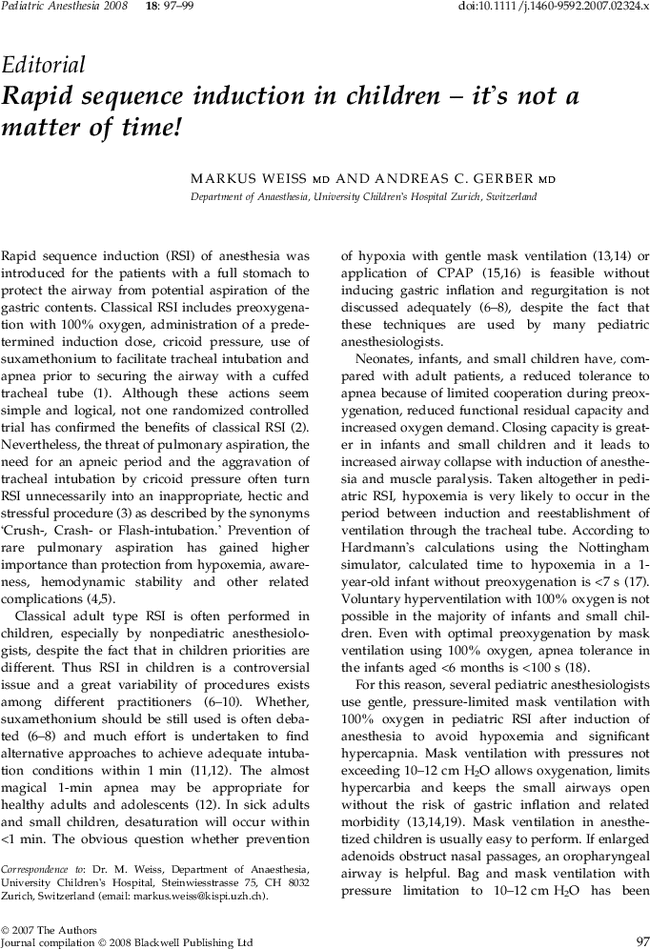Rapid sequence induction in children – it’s not a matter of time!
MARKUS WEISS MD,
ANDREAS C. GERBER MD,
MARKUS WEISS MD
Department of Anaesthesia, University Children’s Hospital Zurich, Switzerland
Search for more papers by this authorANDREAS C. GERBER MD
Department of Anaesthesia, University Children’s Hospital Zurich, Switzerland
Search for more papers by this authorMARKUS WEISS MD,
ANDREAS C. GERBER MD,
MARKUS WEISS MD
Department of Anaesthesia, University Children’s Hospital Zurich, Switzerland
Search for more papers by this authorANDREAS C. GERBER MD
Department of Anaesthesia, University Children’s Hospital Zurich, Switzerland
Search for more papers by this authorDr. M. Weiss, Department of Anaesthesia, University Children’s Hospital, Steinwiesstrasse 75, CH 8032 Zurich, Switzerland (email: [email protected]).

References
- 1 Aitkenhead AR, Smith G. Textbook of Anaesthesia, 3rd edn. Edinburgh: Churchill Livingstone, 1996.
- 2 Freid EB. The rapid sequence induction revisited: obesity and sleep apnea syndrome. Anesthesiol Clin N Am 2005; 23: 551–564.
- 3 Thwaites AJ, Rice CP, Smith I. Rapid sequence induction: a questionnaire survey of its routine conduct and continued management during a failed intubation. Anaesthesia 1999; 54: 376–381.
- 4 Reid C, Chan L, Tweeddale M. The who, where, and what of rapid sequence intubation: prospective observational study of emergency RSI outside the operating theatre. Emerg Med J 2004; 21: 296–301.
- 5 Heier T, Feiner JR, Lin J et al. Hemoglobin desaturation after succinylcholine-induced apnea: a study of the recovery of spontaneous ventilation in healthy volunteers. Anesthesiology 2001; 94: 754–759.
- 6 Zelicof-Paul A, Smith-Lockridge A, Schnadower D et al. Controversies in rapid sequence intubation in children. Curr Opin Pediatr 2005; 17: 355–362.
- 7 Engelhardt T, Strachan L, Johnston G. Aspiration and regurgitation prophylaxis in paediatric anaesthesia. Paediatr Anaesth 2001; 11: 147–150.
- 8 Stedeford J, Stoddart P. RSI in pediatric anesthesia – is it used by nonpediatric anesthetists? A survey from south-west England Pediatr Anesth 2007; 17: 235–242.
- 9
Landsmann I.
Circoid pressure: indications and complications.
Pediatr Anesth
2004; 14: 43–47.
10.1046/j.1460-9592.2003.01202.x Google Scholar
- 10 Brock-Utne JG. Is cricoid pressure necessary? Paediatr Anaesth 2002; 12: 1–4.
- 11 Perry J, Lee J, Wells G. Rocuronium versus succinylcholine for rapid sequence induction intubation. Cochrane Database Syst Rev 2003; 1: CD002788 (Review).
- 12 Stoddart PA, Mather SJ. Onset of neuromuscular blockade and intubating conditions one minute after the administration of rocuronium in children. Paediatr Anaesth 1998; 8: 37–40.
- 13 Lawes EG, Campbell I, Mercer D. Inflation pressure, gastric insufflation and rapid sequence induction. Br J Anaesth 1987; 59: 315–318.
- 14 Weiler N, Heinrichs W, Dick W. Assessment of pulmonary mechanics and gastric inflation pressure during mask ventilation. Prehospital Disaster Med 1995; 10: 101–105.
- 15 Cook TM, Wolf AR, Henderson AJ. Changes in blood-gas tension during apnoic oxygenation in paediatric patients. Br J Anaesth 1998; 81: 338–342.
- 16 Coussa M, Proietti S, Schnyder P et al. Prevention of atelectasis formation during the induction of general anesthesia in morbidly obese patients. Anesth Analg 2004; 98: 1491–1495.
- 17 Hardman JG, Wills JS. The development of hypoxaemia during apnoea in children: a computational modelling investigation. Br J Anaesth 2006; 97: 564–570.
- 18 Patel R, Lenczyk M, Hannallah RS et al. Age and the onset of desaturation in apnoeic children. Can J Anaesth 1994; 41: 771–774.
- 19 Moynihan RJ, Brock-Utne JG, Archer JH et al. The effect of cricoid pressure on preventing gastric insufflation in infants and children. Anesthesiology 1993; 78: 652–656.
- 20 Spears RS Jr, Yeh A, Fisher DM et al. The ‘educated hand’. Can anesthesiologists assess changes in neonatal pulmonary compliance manually? Anesthesiology 1991; 75: 693–696.
- 21 Von Goedecke A, Keller C, Wagner-Berger HG et al. Developing a strategy to improve ventilation in an unprotected airway with a modified mouth-to-bag resuscitator in apneic patients. Anesth Analg 2004; 99: 1516–1520.
- 22 Flick RP, Schears GJ, Warner MA. Aspiration in pediatric anesthesia: is there a higher incidence compared with adults? Curr Opin Anaesthesiol 2002; 15: 323–327.
- 23
Kalinowski CPH,
Kirsch JR.
Strategies for prophylaxis and treatment for aspiration.
Best Pract Res Clin Anaesthesiol
2004; 18: 718–737.
10.1016/j.bpa.2004.05.008 Google Scholar
- 24 Janda M, Scheeren TWL, Nöldge-Schomburg GFE. Management of pulmonary aspiration. Best Pract Res Clin Anaesthesiol 2006; 20: 409–427.
- 25 Warner MA, Warner ME, Warner DO et al. Perioperative pulmonary aspiration in infants and children. Anesthesiology 1999; 90: 66–71.
- 26 Kluger MT, Shor TG. Aspiration during anaesthesia: a review of 133 cases from the Australian anaesthetic incident monitoring study (AIMS). Anaesthesia 1999; 54: 19–26.
- 27 Warner MA, Warner ME, Webber JG. Clinical significance of pulmonary aspiration during the perioperative period. Anesthesiology 1993; 78: 56–62.
- 28 Meek T, Gittins N, Duggan JE. Circoid pressure: knowledge and performance amongst anaesthetic assistants. Anaesthesia 1993; 10: 27–32.
- 29 Brimacombe JR, Berry AM. Cricoid pressure. Can J Anaesth 1997; 44: 414–425.
- 30 Hartsilver EL, Vanner RG. Airway obstruction with cricoid pressure. Anaesthesia 2000; 55: 208–211.
- 31 Tournadre JP, Chassard D, Berrada KR et al. Cricoid cartilage pressure decreases lower esophageal sphincter tone. Anesthesiology 1997; 86: 7–9.
- 32 Vanner RG. Tolerance of cricoid pressure by conscious volunteers. Int J Obstet Anesth 1992; 1: 195–198.




